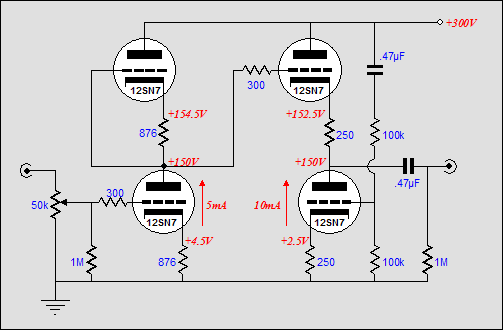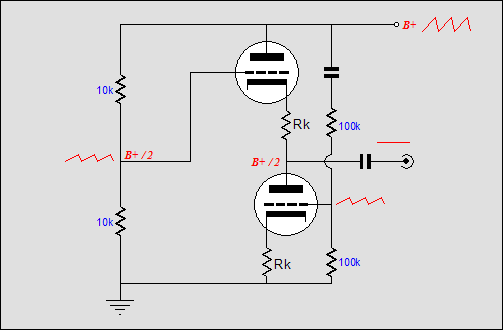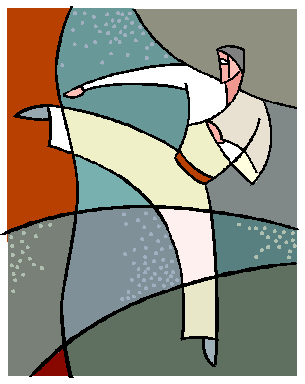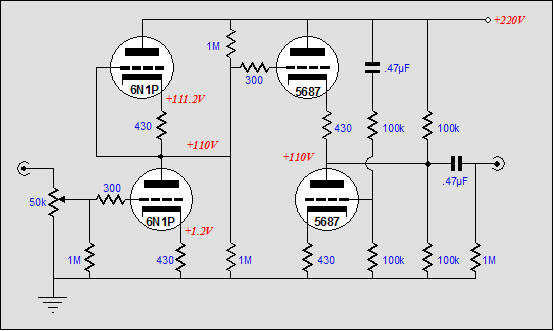| John Broskie's Guide to Tube Circuit Analysis & Design |
|
||||
08 November 2004 New Tube Circuit: The Aikido Amplifier I created this line stage circuit a few years ago during a correspondence with a reader from Canada named Paul. I wanted to help Paul make the best use of three 12AU7s in his line amplifier. This circuit was just one of many possibilities. When designing a circuit, I start with a seed idea and then draw as many variations or, rather, permutations as my mind can create. Then, I pull back and look at the array of circuits, evaluating each one against some stated goal. This circuit was one permutation, which can now serve as a seed idea to generate another ten permutations. Belonging to my school of Audio Aikido, this amplifier sidesteps power supply noise by incorporating the noise into its normal operation. As a result, in terms of distortion and output impedance and PSRR, the following circuit works at least a magnitude better than the equivalent SRPP or grounded-cathode amplifier. The improved PSRR advantage is important, for it greatly unburdens the power-supply design and it helps prevent the signal from recirculating through the power supply (an important issue that few address). With no tweaking or tube selecting, with the last solder joint still warm, I was able to get a -30dB PSRR (a conventional grounded-cathode amplifier with the same tubes and current draw yields a -6dB PSRR). I showed the circuit to a few readers and it ended up on some DIY website, where it was dismissed out of hand; which is interesting, considering that no one had actually built it, tested it, let alone listened to it. Maybe I should get these armchair critics to tell what a bottle of wine will taste like it prior to uncorking the bottle. In the schematic below, the triodes are so specified for example only. The circuit does not rely on them or any other specific triode to work correctly. It's the topology... many believe that a different triode equals a different topology; it doesn't. Making this mistake would be like thinking that the essential aspect of being a seeing-eye dog rested in being a Golden Lab. WE300Bs and 845s can be forced into use just as easily as 12AX7s and 6922s can. The only requirement is that each stage use the same tube type. For example, a 6SL7 can cascade into a 6BX7.  Aikido Amplifier Well, several readers have now actually built the circuit and here are two descriptions from the readers: "I am quite amazed by the sound: very fast, clean and accurate" and "I have to say that the [line] amplifier is dead quiet, open sounding, and absolutely neutral, but still fluid...[It] sounds like some many-thousand-dollar preamp." Of course, you should believe no claim until your own ears perform an evaluation. But good sound is not enough, I only now realize. A name is needed. Without a name, a circuit will quickly disappear from memory (and Google). So here it is: the Aikido Amplifier. (Since it could form the foundation of a phono preamp or a tube-based headphone amplifier, "Line" has been dropped from its original title.) How it works If the output connection is taken from the the cathode follower's cathode, then the balance will be broken. The same holds true if the cathode follower's cathode resistor is removed. (Besides, this resistor actually makes for a better sounding cathode follower, as it linearizes the cathode follower at the expense of a higher output impedance.) 
Note also the absence of any cathode resistor bypass capacitors; these caps are very much in the signal path and very few do not damage the sound, unless high quality capacitors are used. If a cathode resistor bypass capacitor is used on the input stage's bottom triode, then the two resistor voltage divider ratio must be changed from 50% to match the new AC noise divider ratio imposed by the input stage. In other words, much less PS noise noise will need to be injected into the cathode follower's bottom triode's grid.
In the schematic above, safety resistors have been added. The two 1M resistors save the second stage should the input tube be yanked from its socket or its heater opened. The two added 100k resistors save the power amplifier should the cathode follower tube be yanked from its socket, as the same DC voltage will be presented to the coupling capacitor. //JRB |
TCJ My-Stock DB TCJ My-Stock DB helps you know just what you have, what it looks like, where it is, what it will be used for, and what it's worth. TCJ My-Stock DB helps you to keep track of your heap of electronic parts. More details. Version 2 Improvements *User definable Download or CD ROM |
|||
| www.tubecad.com Copyright © 1999-2004 GlassWare All Rights Reserved |












